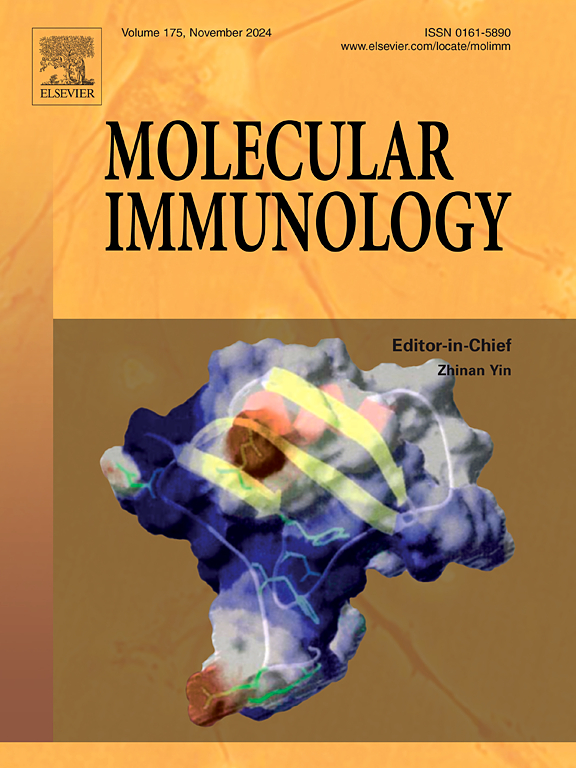牛蒡子通过Apoh/PPAR-γ途径减轻糖尿病肾病
IF 3.2
3区 医学
Q2 BIOCHEMISTRY & MOLECULAR BIOLOGY
引用次数: 0
摘要
背景:糖尿病肾病(DN)以肾脏纤维化和功能下降为特征。载脂蛋白H (Apoh)和传统药用植物牛蒡子(Fructus arctii)已被证明具有治疗代谢和纤维化疾病的潜力。本研究旨在揭示载脂蛋白oh和牛蒡子在减轻DN中的作用。方法以sdb /db小鼠作为DN模型,用高糖(HG)处理小鼠肾小球系膜细胞(mMCs)和肾小管上皮细胞(mTECs),体外模拟DN。采用shRNA和pcDNA3.1载体进行Apoh沉默和过表达。牛蒡子分别用于细胞和动物模型,以评估其治疗潜力。采用CCK-8和EdU检测细胞增殖,采用Western blot、IHC和RT-qPCR分析纤维化标志物。通过拮抗剂GW9662治疗,证实PPAR-γ通路参与。采用H&;E、PAS、马松三色、小天狼星红等组织学染色评价肾脏结构变化。结果在hg处理的细胞和db/db小鼠肾脏中apoh的表达明显降低。过表达Apoh通过下调cyclin D1和PCNA抑制hg诱导的mMCs和mTECs的增殖。此外,Apoh过表达通过降低纤维连接蛋白、I型胶原和α-SMA水平来减轻纤维化,这种作用是通过PPAR-γ途径介导的。用PPAR-γ拮抗剂GW9662治疗逆转了这些保护作用。在db/db小鼠中,牛蒡子通过降低血糖、蛋白尿和肾脏胶原沉积来改善肾功能。它还能减轻纤维化,增强Apoh和PPAR-γ的表达。沉默Apoh可消除牛蒡子对细胞增殖和纤维化的保护作用,证实其依赖于Apoh/PPAR-γ途径。结论牛蒡子通过Apoh/PPAR-γ通路调节细胞增殖和肾纤维化,减轻DN进展。本文章由计算机程序翻译,如有差异,请以英文原文为准。
Fructus arctii mitigates diabetic nephropathy via the Apoh/PPAR-γ pathway
Background
Diabetic nephropathy (DN) is characterized by renal fibrosis and functional decline. Apolipoprotein H (Apoh) and Fructus arctii, a traditional medicinal plant, have demonstrated potential in treating metabolic and fibrotic disorders. This study Focused on revealing the roles of Apoh and Fructus arctii in mitigating DN.
Methods
Db/db mice served as an in vivo DN model, and mouse glomerular mesangial cells (mMCs) and renal tubular epithelial cells (mTECs) were treated with high glucose (HG) to simulate DN in vitro. Apoh silencing and overexpression were performed using shRNA and pcDNA3.1 vectors. Fructus arctii was administered to both cellular and animal models to assess its therapeutic potential. Cellular proliferation was measured using CCK-8 and EdU assays, while fibrosis markers were analyzed by Western blot, IHC and RT-qPCR. PPAR-γ pathway involvement was confirmed through treatment with the antagonist GW9662. Renal structural changes were evaluated with histological staining including H&E, PAS, Masson’s trichrome, and picrosirius red staining.
Results
Apoh expression was markedly reduced in HG-treated cells and the kidneys of db/db mice. Overexpression of Apoh suppressed HG-induced proliferation in mMCs and mTECs by downregulating cyclin D1 and PCNA. Additionally, Apoh overexpression alleviated fibrosis by reducing Fibronectin, Collagen I, and α-SMA levels, effects mediated through the PPAR-γ pathway. Treatment with the PPAR-γ antagonist GW9662 reversed these protective effects. In db/db mice, Fructus arctii administration improved renal function by reducing blood glucose, proteinuria, and renal collagen deposition. It also alleviated fibrosis and enhanced Apoh and PPAR-γ expression. Silencing Apoh nullified the protective effects of Fructus arctii on cell proliferation and fibrosis, confirming its reliance on the Apoh/PPAR-γ pathway.
Conclusion
Fructus arctii alleviated DN progression by modulating cell proliferation and renal fibrosis via the Apoh/PPAR-γ pathway.
求助全文
通过发布文献求助,成功后即可免费获取论文全文。
去求助
来源期刊

Molecular immunology
医学-免疫学
CiteScore
6.90
自引率
2.80%
发文量
324
审稿时长
50 days
期刊介绍:
Molecular Immunology publishes original articles, reviews and commentaries on all areas of immunology, with a particular focus on description of cellular, biochemical or genetic mechanisms underlying immunological phenomena. Studies on all model organisms, from invertebrates to humans, are suitable. Examples include, but are not restricted to:
Infection, autoimmunity, transplantation, immunodeficiencies, inflammation and tumor immunology
Mechanisms of induction, regulation and termination of innate and adaptive immunity
Intercellular communication, cooperation and regulation
Intracellular mechanisms of immunity (endocytosis, protein trafficking, pathogen recognition, antigen presentation, etc)
Mechanisms of action of the cells and molecules of the immune system
Structural analysis
Development of the immune system
Comparative immunology and evolution of the immune system
"Omics" studies and bioinformatics
Vaccines, biotechnology and therapeutic manipulation of the immune system (therapeutic antibodies, cytokines, cellular therapies, etc)
Technical developments.
 求助内容:
求助内容: 应助结果提醒方式:
应助结果提醒方式:


